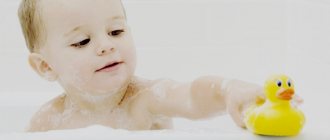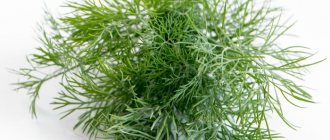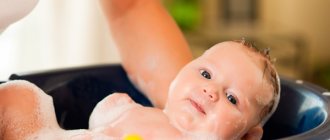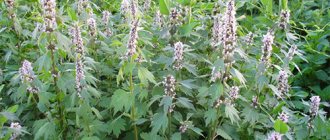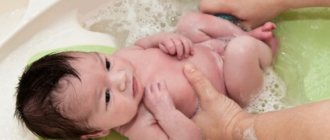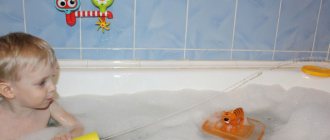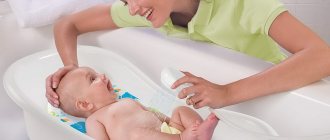Which herbs are best for bathing newborns, which ones are soothing and how to brew them correctly. The delicate, soft and sensitive skin of a newborn baby requires a lot of effort and effort for proper care.
It is necessary to bathe a newborn baby more often, because throughout the whole day the baby’s skin accumulates food debris, saliva, sweat and even dead, unnecessary skin cells, which in turn must be removed so that redness, irritation and allergy.
Remember that all the herbs I listed below, entering the child’s body through the skin, have only a healing effect on him, but also have a beneficial effect on the entire body in general.
Herbs for bathing newborns with their healing properties can relieve fatigue, tension, irritation, allergies, reduce skin inflammation, and have an antibacterial and anti-inflammatory effect, plus the herbs fight dead cells that the body does not need.
To speed up the healing process of the umbilical wound, I advise adding special disinfectant herbs to the water bath; these herbs can be:
- chamomile,
- calendula,
- series,
- Oak bark,
- sage,
- celandine and others.
If the baby’s skin breaks out, I recommend bathing him in the herbs of chamomile, string, sage or celandine.
Herbs for bathing newborns need to be alternated periodically, since daily bathing a baby in the same herbal infusion can lead to an allergic reaction.
The string needs to be brewed like this: take about 150 grams of herb, fill it with one liter of boiled herb, and let it steam for about ten minutes, then filter it and pour it into a baby bath along with warm water.
The sequence, like other herbs, can be alternated with other herbs in different proportions, but no more than two tablespoons.
For example, like this: mix two tablespoons of string with two tablespoons of sage, or with two tablespoons of chamomile or sage. You can mix two spoons of string with a couple of spoons of thyme.
If you use chamomile for bathing, then steam it as follows. For one liter of boiled water, add a tablespoon of chamomile and let it brew for ten minutes.
After this, you receive a chamomile decoction ready for use in the bath along with bathing water. The color of the herbal solution in the bath along with water should be slightly transparent and colored.
In order to prepare a herbal infusion of celandine, add 50 grams of this herb to half a liter of boiled water, preferably in an enamel bowl, cover it all with a lid, and heat the infusion in a water bath for half an hour.
After heating, cool the celandine infusion at room temperature for no more than fifteen minutes. Then we filter it, drain it and pour it into a previously prepared glass container and close it tightly with a lid.
The decoction will need to be used within 2 days. It should stand in a dark and cool place. Before taking water treatments, add no more than one glass of the prepared decoction to the bath.
I would like to add that in addition to celandine, sage herbs also have antimicrobial, softening and anti-inflammatory effects.
To bathe a newborn in sage, you need to steam one tablespoon of the herb with one glass of boiled water, let it brew for about twenty minutes, strain it thoroughly and add it to the bath before bathing.
I note that it is best to bathe a newborn baby before bedtime, since in addition to antimicrobial effects, all of the above herbs have calming effects.
Herbs for bathing newborns can be collected at home or purchased in pharmacies either in bulk or in ready-made prepackaged bags. If you can't collect herbs, buy herbs in bags.
The benefits of herbal infusions for bathing newborns have been known for a long time. If you choose the right herb for bathing your baby, a nightly bath will not only be a hygienic procedure, but will help normalize the baby’s nervous system. Baths can be taken as soon as the umbilical cord has healed.
Bathing with the addition of herbs is indicated for both healthy babies and those with problems: dermatitis, allergic reactions, hypertonicity, hypotonicity, increased excitability, stomach colic.
Bathing a child in herbs - herbs for bathing a child
The baby's first bath will usually take place in the evening, upon arrival home from the maternity hospital. The whole family is excitedly preparing for this event, in which everyone participates - dads, grandmothers, older sisters/brothers, etc. It is customary to bathe a baby in warm water at a temperature of 37-37.5 °C, poured into a bathtub directly from the tap. It is not advisable to boil water for bathing a baby; even in the maternity hospital, immediately after the birth of the baby, they wash it with water from a centralized water supply. (What water to bathe a newborn baby in) You can add herbs to the water for bathing the baby, which will be discussed below.
We invite you to familiarize yourself with Installation of a sewerage system. Biases, rules and consistency.
Bathing a child in herbs has a beneficial effect on the infant's body. The herbs selected are single-component; you should not mix several herbs for one bath, as they may be incompatible with each other and cause an allergic rash. Before immersing the child in water with a decoction of herbs, use a cotton swab dipped in the decoction to wipe a small area of the child’s skin (on the arm or leg, without touching the face). If within 15 minutes the skin does not change - it does not turn red, or a small rash appears, then you can bathe your child in a decoction of this herb without fear.
Therapeutic mixtures for herbal baths
In addition to mono-compositions, there are combined collections for various purposes:
- calming;
- to relieve colic;
- to normalize tone.
They are used in consultation with a doctor. Ready-made formulations are good because the components are balanced, fit together and enhance their mutual action. For pediatric procedures, dosage is extremely important. Often parents mistakenly use “adult” concentrations, and then cannot understand the reason for the child’s violent reaction to the bath.
If the package says: “1 tablespoon per liter of water,” then this is a “large” dose; for a child it is reduced by 3-4 times. It is not recommended to use self-grown (purchased, taken from random people) herbs: it is unknown in what conditions they ripened, what they absorbed from the soil when they were collected.
For skin diseases
For dermatitis, rashes, as well as for their prevention, Altai herbs (the composition is called that), the collection of chamomile inflorescences, sage, flaxseed, decoctions of oak bark and birch buds help. There is no need to try all the recipes at once; you need to start with one specific one.
To reduce infant nervousness
The calming, relaxing effect of herbs is well known. For overly nervous children, baths made from a mixture of chamomile and elderberry (flowers) will help. There is a special sedative mixture (sold in pharmacies), it is only important to adjust the dose in relation to the baby bath.
Most herbs and compositions have a complex effect, simultaneously acting as restorative, sedative and preventive (against acute respiratory infections) agents. The most common natural sedatives include valerian (root), pine needles, mint leaves, lavender, and motherwort.
For intestinal colic
A warm bath with a temperature of 30-35 degrees has a beneficial effect on the smooth muscles of the intestines and relieves spasms in babies. If you enhance its effect with a decoction of bearberry, collecting motherwort, and hop cones, the child will calm down faster and get rid of stomach pain.
To normalize the baby's muscle tone
Spasmodic contractions in the muscles cause pain and prevent the baby from actively playing, sleeping or moving. To get rid of unpleasant phenomena, herbal remedies are widely used and a course of treatment is carried out (several baths).
For hypertension
A warm bath, taken for 10 days, with the addition of valerian, sage, motherwort, and pine needles will help the baby more calmly endure the inevitable process of changing the state of muscle fibers. And in combination with a massage, the effect will be even more significant.
For hypotension
Lethargy and weak muscle tone are no less a problem than muscle spasms. And for this case there is a remedy: a combination of nettle, oregano, string, chamomile, lavender and sage. It is not recommended to use decoctions before the baby reaches the age of 4 months.
If sleep patterns are disturbed
Does your baby sleep poorly, is anxious, or can’t switch gears for a long time after playing? It doesn’t matter, there are special sleepy herbs that relieve hyperactivity. Baths with infusions of valerian, lavender, chamomile, and motherwort in small concentrations will help the child relax and fall asleep quickly and soundly.
For colds
For the prevention and treatment of colds, bathing in infusions of oak bark, eucalyptus, coltsfoot, pine needles, and wild rosemary is recommended. The child will feel better, his nose will clear, and breathing will become easier. It is not recommended to perform procedures at high temperatures.
Calendula for bathing babies
Every day, from the first days, it is important to carry out preventive and developmental massage for the child, and, if necessary, therapeutic massage (for hypertonicity, for example). Calendula oil can be used during massage. It can also be used to lubricate allergic rashes and insect bites. In the summer, if the baby has been bitten by mosquitoes, the best remedy is marigold oil - it will quickly relieve inflammation and itching. In winter it will help with chapping. Calendula oil can be purchased at the pharmacy, or you can prepare it at home. Place fresh flowers of the plant in a glass jar (3/4), pour in olive oil and leave for 10 days in a dark, cold place, shaking the container daily. After this period, the oil is filtered and stored in the refrigerator.
Contraindications
External use of preparations with sage should be discontinued if they cause an allergic reaction. It is a small rash on the skin.
You should not take infusions and teas with sage during a strong, ongoing cough or pregnancy.
It is very dangerous to take sage preparations orally if there are estrogen-dependent neoplasms in the pelvic organs. Their supply with estrogen will stimulate the development of tumors, including malignant ones. Among such diseases, the most dangerous are mastopathy, endometriosis and endometrial hyperplasia.
Sage is used with caution in acute inflammatory kidney diseases, hypotension and weakened thyroid function. It is not recommended to use sage for people who have epilepsy. The substances included in its composition can provoke a seizure.
Contraindications to the use of sage tablets are, in addition to all those previously listed, fructose intolerance and phenylketonuria. It is not advisable to drink alcohol during treatment with sage.
Overdose symptoms:
- increased body temperature;
- dizziness;
- for hypertension - sudden changes in blood pressure;
- headache;
- noise in ears;
- nausea, vomiting;
- stomach pain.
Sage may cause drowsiness, so it is better not to drive while taking it. The maximum period of treatment with sage is 3 months.
It is necessary to coordinate with your doctor the ingestion of sage preparations along with medications such as:
- drugs to lower blood pressure;
- warfarin, heparin, clopidogrel;
- non-steroidal anti-inflammatory drugs (ibuprofen, acetylsalicylic acid, etc.);
- antidiabetic drugs;
- benzodiazepines;
- sedatives;
- codeine;
- antidepressants.
Sage flowers
Helpful information
Coniferous extract – pine baths are an excellent remedy for strengthening the immune system and the general condition of the body, combating the first signs of depression and chronic fatigue. The needles contain many vitamins, essential oils, microelements, tannins and mineral salts, which have a beneficial effect on the respiratory organs, skin, cardiac and nervous systems. Pine decoction has a diaphoretic and choleretic effect, a folk treatment for allergies, and also improves metabolism. It is better to buy pine extract in concentrated form.
We suggest you read: Is it possible to change water meters yourself?
What is suitable for daily hygiene of a healthy baby?
There is only one child, but there are many smart compositions for bathing: to relieve colic, normalize sleep, for muscle hypertonicity, tonics, to increase appetite. It is recommended to start with one thing, gradually alternating different compositions. For example, a decoction of chamomile petals has never harmed anyone; pediatricians continue to recommend it for rashes and insomnia, as an initial decoction for bathing.
Chamomile flowers
A universal remedy. Chamomile is included in various preparations. It is also used as an independent component. Children who begin to bathe in a decoction of inflorescences quickly get used to the smell, perceive herbal medicine positively, and enjoy it. For daily bathing - the best option.
Series
As soon as the umbilical wound has healed, you can begin to bathe the child in a bath with the addition of a decoction of the string. Relieves rash symptoms, but dries the skin (therefore, it is not used more often than once every 7 days). It is acceptable to replace lotions on problem areas.
Calendula
Calendula inflorescences will help relieve pain and spasms. They have a general relaxing effect and are a herbal medicine with a diuretic and anti-inflammatory effect.
Nettle
Stinging prickly nettle is useful as a medicine for relieving inflammation, healing wounds and abrasions. Calms hyperactive toddlers and strengthens the children's body.
Sage
Indispensable for the prevention of acute respiratory infections, before bedtime, to help the child relax and switch gears. Helps relieve hypertension and heal the navel.
Lavender
One of the “sleepy” herbs. The soft, pleasant smell improves mood and acts as a natural sleeping pill.
Hop
Hop cones are rich in tannins and oily substances and have a beneficial effect on the child’s psyche. The plant is included in the collections for normalizing hypertension.
Oak
The power of oak is well known; its bark is used in the preparation of compositions to relieve inflammation, destroy hostile microflora, and as a disinfectant.
Birch
Birch buds with leaves are indicated for the treatment of diaper rash. They will replace powders and creams from proprietary manufacturers, and are also completely harmless.
Melissa
Melissa is similar in action and appearance to mint, they are often confused. Has a characteristic “fresh” smell. Normalizes intestinal function, relieves spasms, eliminates anxiety.
Valerian
Natural relaxant. Improves digestion, strengthens blood vessels and the heart, calms impressionable, easily excitable children.
Thyme
Another “calm down” and “calm down” for active little ones. It has no side effects, unlike synthetic drugs.
Motherwort
The general calming effect of motherwort in tincture is known to adults. When used externally, in the form of a decoction, it normalizes the functioning of the intestinal tract in children and relieves spasms.
Mint
Peppermint, due to its aroma, increases appetite and relieves pain. It has an analgesic effect and has a beneficial effect on the nervous system.
Oregano
A general strengthening, soothing, preventive remedy for daily bathing. Recommended for evening baths to help your baby relax and fall asleep soundly.
Bearberry
Included in preparations for relieving spasmodic colic, relieving attacks of nervousness and excitability. Indispensable for normalizing the functioning of the gastrointestinal tract.
St. John's wort
Treats minor abrasions and wounds, damage to the epidermis. Recommended by pediatricians for the treatment of diathesis and dermatitis. Helps improve overall immunity.
Needles
Fragrant needles are useful as a diaphoretic, choleretic and tonic. Indicated for acute respiratory infections (aroma oils clear the airways), for prevention.
Sweet clover
Gives healthy sleep, indispensable for allergic dermatitis and skin rashes. In terms of effectiveness, it is successfully ahead of ointments and creams.
Juniper
The rich, resinous smell of juniper buds is difficult to confuse with anything else. Due to the presence of phytoncides, it is necessary for the prevention of colds, as a general tonic herbal medicine.
How to brew calendula for bathing newborns
Calendula is widely used in medicine due to a whole list of unique properties. It soothes the skin, accelerates wound healing, eliminates redness, reduces muscle spasms, destroys fungi and microbes, and has powerful antiseptic and anti-inflammatory properties. To treat the baby's skin, pour calendula (1 tablespoon) with boiled warm water (200 ml). Then soak a gauze or cotton swab in this product and gently wipe the rash areas. For frostbite and burns, you can make lotions. Calendula tincture is diluted with water (1:3), a napkin is moistened in the resulting product, and applied twice a day for 10 minutes.

